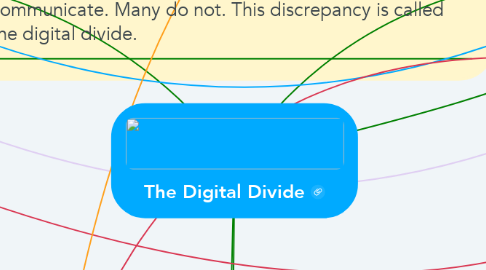The Digital Divide
by Laura Lyons

1. THE ISSUE OF THE DIGITAL DIVIDE The Internet is an extremely important part of our society. More people are connected to the Internet than ever before, but a large part of this increase is due to Smartphones, which do not provide the same learning opportunities and capabilities as computers (Brown, 2016). Because so many teachers are assigning tasks that require use of the Internet outside of school, it is becoming an issue that so many students do not have access at home. It is also an issue that many people do not know how to use digital tools even if they have a computer with Internet access. Now, more than ever before, connecting to others and being a part of a community requires advanced use of technology, the use of computers with Internet access. Many people regularly use technology in their homes. Many do not. Many people use digital tools to learn and communicate. Many do not. This discrepancy is called the digital divide.
2. Solutions
2.1. IMPROVING ACCESS Offering free Internet access to make completing homework less of a challenge for those without access at home can improve the divide (Kang, 2016). The Federal Communications Commission has revamped the Lifeline plan to make broadband free and affordable in public housing.
2.2. PROGRAMS Initiatives can help bridge the digital divide, like Glitch Game Testers, a program designed to interest African American boys in computer science, and The Verizon Innovative Learning Schools program, which is in the midst of providing tablets to underprivileged students at Title I middle schools (Reich & Ito, 2017).
2.3. GAINING INTEREST Gaining the interest of minority youth helps them to feel less excluded when technology is used and more empowered in regards to digital learning (Reich & Ito, 2017).
2.4. TARGETING NEEDS Technology developers should learn about the specific needs of communities they serve to minimize feelings of exclusion and stereotype threats (Reich & Ito, 2017). It is also important to use technology to support students in high-risk situations like starting college or switching schools (Reich & Ito, 2017).
2.5. LEARNING EXPERIENCES Offering education for parents as well as students make families able to see the importance of digital literacy. The Family Creative Learning project is an example of an initiative that engages parents and children in technology-focused workshops (Reich & Ito, 2017). Developers should also mandate funds for digital education and utilize public entities to reach people who are not tech-savvy (Sassi & Wyber, 2018).
3. Digital Inclusion
3.1. ACCESS - Doing what is necessary to ensure that everyone, even the most disadvantaged people,have access to technology.
4. Obstacles
4.1. ACCESS About 52% of the world remains offline (Sassi & Wyber, 2018). Approximately 1/3 of homes do not have broadband Internet connectivity in cities like Detroit, Miami, and New Orleans (Kang, 2016). Smartphones are not capable of allowing students to work extensively on things like research, creative projects, and writing assignments (Brown, 2016).
4.2. SCHOOLS Schools that serve economically advantaged youth use technology in more advanced and meaningful ways than those serving disadvantaged youth (Reich & Ito, 2017). Digital Divide: The Technology Gap between the Rich and Poor
4.3. CULTURAL BARRIERS Professionals who develop technology tools do not relate to underprivileged learners (Reich & Ito, 2017). Minority students often feel like outsiders in their learning environments, which affects their performance (Reich & Ito, 2017). School personnel often lack understanding of students' cultures and home lives, which makes connections through technology difficult (Reich & Ito, 2017).
4.4. SOCIOECONOMIC STATUS Approximately 5 million families in the United States do not have Internet access at home (Kang, 2016).
4.5. LITERACY Even if broadband is available to everyone in our society, people must know how to use the Internet effectively. Without digital skills, there is still a risk of separation among groups of people (those who use the internet to connect to others and learn and those who do not (Sassi & Wyber, 2018).
5. Digital Equity
5.1. LITERACY - When every community and individual has internet access and is computer literate in a way that fulfills the needs of our society (Siefer, 2016).


